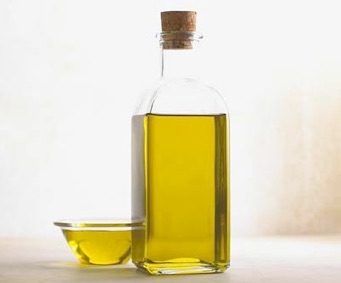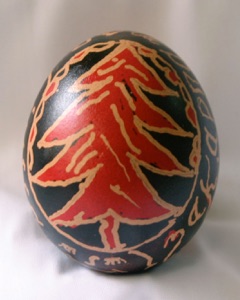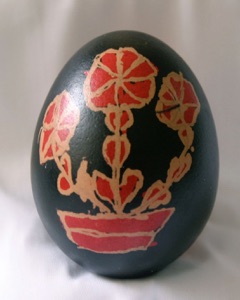Natural Finishes

You may wish to apply a glossy (or satin) finish to your pysanka once it is completed. Traditional Ukrainian pysanky were not varnished–to make them shiny, the pysanka-maker might rub a bit of goose or pork fat over the completed shell. While this may look fine in the short term, in the long term dust and grime accumulate and mar the finish.
In past times there was no need to protect pysanky from water damage, as natural dyes were water fast. And, since pysanky were only kept for a year or so, as they had a talismanic rather than decorative role, there was no need to worry about dust or grime collecting on them.
If I am planning to keep pysanky for any length of time, I will empty and varnish them. But it is not always practical to do so–if teaching large classes, or in some settings (e.g. a summer camp in the mountains of Ukraine). In such cases “natural” non-varnish finishes might be just the ticket.
Some pysankary have told me that they use a bit of olive oil, rubbing it on the finished pysanka and giving a nice glow to the shell. It is worth a try, and the oil will still allow the egg to breathe, although not as well as before.

A suggestion given to me by Vira Manko was to use Vaseline (petroleum jelly). Although not really “natural” as such (it is a petroleum product), its physical properties are similar to those of animal fat, at least from a pysankarstvo perspective. She told me that she applies Vaseline to her finished pysanky, to give them a nice glow and protect the finish. She feels that this replicates the look of traditional pysanky, which were never highly glossy. (See bottom pysanka above.)

I have found vaseline to be useful when teaching pysankarstvo away from home. When I teach in my area, I take all the students’ eggs home, and varnish and empty them. Since I can’t do this away from and especially for one-day classes, I have found vaseline to be a nice finish. I apply it first, a bit thickly, before emptying the egg. Eggs can be emptied either by me, or by the student, during class. The vaseline will protect the egg from splashes of egg white and yolk, and of water (if the interior is further rinsed).
Once the egg has been cleaned out, the vaseline can be rubbed off with a paper towel. A coat will remain, worked into the shell, which will provide a bit of satiny shine, and which will further protect the egg from moisture. The two top eggs in the photo array above were made by my students at summer camp in 2009; they have a light coating of vaseline to protect and shine.
Back to Main Finishing page
Back to Main Pysankarstvo page
Search my site with Google
Pretty Shiny Pysanky






